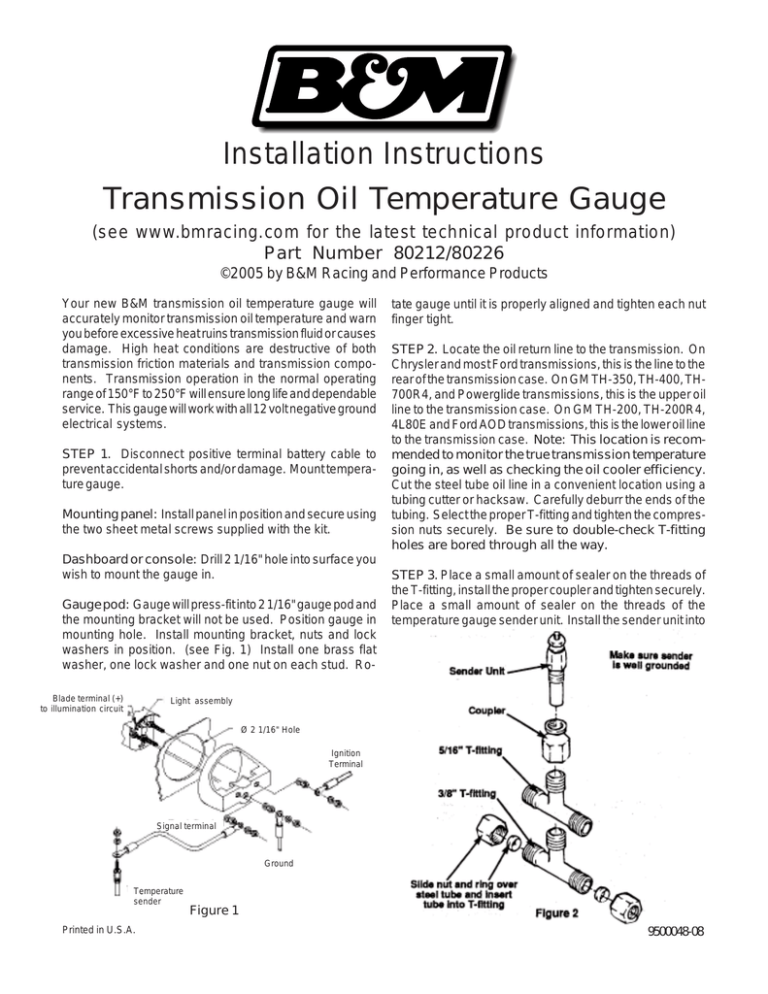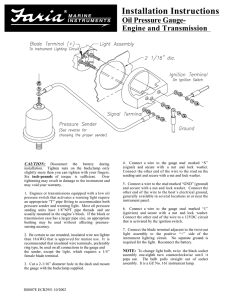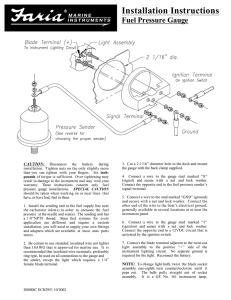Installation Instructions Transmission Oil Temperature Gauge
advertisement

Installation Instructions Transmission Oil Temperature Gauge (see www.bmracing.com for the latest technical product information) Part Number 80212/80226 ©2005 by B&M Racing and Performance Products Your new B&M transmission oil temperature gauge will accurately monitor transmission oil temperature and warn you before excessive heat ruins transmission fluid or causes damage. High heat conditions are destructive of both transmission friction materials and transmission components. Transmission operation in the normal operating range of 150°F to 250°F will ensure long life and dependable service. This gauge will work with all 12 volt negative ground electrical systems. STEP 1. Disconnect positive terminal battery cable to prevent accidental shorts and/or damage. Mount temperature gauge. Mounting panel: Install panel in position and secure using the two sheet metal screws supplied with the kit. Dashboard or console: Drill 2 1/16" hole into surface you wish to mount the gauge in. Gauge pod: Gauge will press-fit into 2 1/16" gauge pod and the mounting bracket will not be used. Position gauge in mounting hole. Install mounting bracket, nuts and lock washers in position. (see Fig. 1) Install one brass flat washer, one lock washer and one nut on each stud. RoBlade terminal (+) to illumination circuit tate gauge until it is properly aligned and tighten each nut finger tight. STEP 2. Locate the oil return line to the transmission. On Chrysler and most Ford transmissions, this is the line to the rear of the transmission case. On GM TH-350, TH-400, TH700R4, and Powerglide transmissions, this is the upper oil line to the transmission case. On GM TH-200, TH-200R4, 4L80E and Ford AOD transmissions, this is the lower oil line to the transmission case. Note: This location is recommended to monitor the true transmission temperature going in, as well as checking the oil cooler efficiency. Cut the steel tube oil line in a convenient location using a tubing cutter or hacksaw. Carefully deburr the ends of the tubing. Select the proper T-fitting and tighten the compression nuts securely. Be sure to double-check T-fitting holes are bored through all the way. STEP 3. Place a small amount of sealer on the threads of the T-fitting, install the proper coupler and tighten securely. Place a small amount of sealer on the threads of the temperature gauge sender unit. Install the sender unit into Light assembly Ø 2 1/16" Hole Ignition Terminal Signal terminal Ground Temperature sender Printed in U.S.A. Figure 1 9500048-08 the coupler and TIGHTEN VERY LIGHTLY! STEP 4. Run a length of wire from the temperature gauge to the sender unit using the wire supplied with the kit. Bare 1/4" of the end of the wire supplied at the sender unit. Install an eyelet terminal supplied with the kit on the end of the wire and crimp it tightly with a pair of pliers. Install the terminal onto the sender unit stud. Install nut on to the stud and tighten securely. Be sure the terminal does no touch the body of the sender. Tape the wire in position so it cannot touch any hot engine components. Be sure that the base of the sending unit is properly grounded. A sending unit installed in a rubber cooler line is not properly grounded. Improper grounding will cause a false reading. Install another eyelet terminal on the end of the temperature gauge wire. Remove the nut and lock washer from the left-hand stud on the temperature gauge (see Figure 1). Install the terminal onto the stud and install lock washer and nut. Tighten nut snugly. DO NOT OVER-TIGHTEN AS THIS COULD DISTORT BRACKET OR DAMAGE GAUGE. STEP 5. Run a length of wire from the temperature gauge to the ignition switch or fuse block using the wire supplied with the kit. Bare 1/4" of the end of the wire at the temperature gauge. Install an eyelet terminal on the end of the wire and crimp it tightly with a pair of pliers. Remove the nut and lock washer from the right-hand stud on the temperature gauge (see Figure 1). Install the terminal onto the stud and install lock washer and nut. Tighten nut snugly. DO NOT OVER-TIGHTEN AS THIS COULD DISTORT BRACKET OR DAMAGE GAUGE. Connect other end of wire to an accessory or ignition circuit that is "hot" when the ignition key is on. DO NOT ALLOW "HOT" WIRE TO TOUCH SENDER TERMINAL ON TEMPERATURE GAUGE. STEP 6. Tighten nut and lock washer on center ground terminal snugly. Note: If you have mounted the gauge on an insulated panel such as a plastic dashboard, you will have to run a ground wire from the center terminal to chassis ground (frame or body). DO NOT OVER-TIGHTEN AS THIS COULD DISTORT BRACKET OR DAMAGE GAUGE. STEP 7. Run a length of wire from the temperature gauge to the dashboard instrument light wires or terminal board. Bare 1/4" of the end of wire at the temperature gauge. Install the female spade connector furnished and crimp tightly with a pair of pliers. Slip connector onto gauge spade terminal (see Figure 1). Tape or fasten all wires up out of the way from heat or any moving parts to prevent damage. STEP 8. Re-connect battery cable. Turn ignition key on. Gauge will read oil temperature. Start engine and check Tfitting for leaks. As transmission oil temperature warms up, the gauge will indicate properly. Turn on lights to check operation of illumination bulb. Tool List Parts List 7/16" Wrench 1/2" Wrench 9/16" Wrench 5/8" Wrench 3/8" Socket or Nut driver Pliers Wire strippers Tubing cutter Small file Phillips Screwdriver 1/8" Drill bit Drill Temperature Gauge Bracket Eyelet terminals (3) Spade terminal Brass washers (3) Lock washers (4) Nuts (3) Coupler Hook-up wire Mounting screws (2) Mounting panel 3/8 " T-fitting 5/16" T-fitting Sender Unit (1/8" NPT) TROUBLE SHOOTING GUIDE Malfunction Probable Cause Gauge shows no reading -Gauge is not hooked to power, or is not grounded properly Gauge shows false reading -Sending unit no properly grounded Reading too high -Power and ground wire reversed Needle goes to extreme right -Lead to sender assembly accidentally grounded




